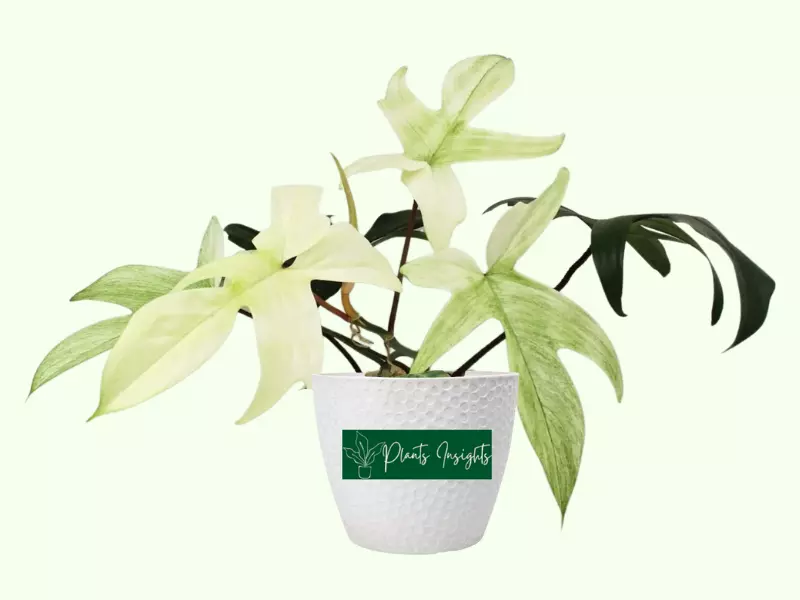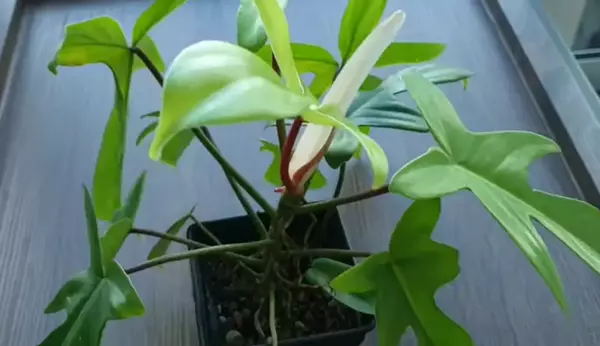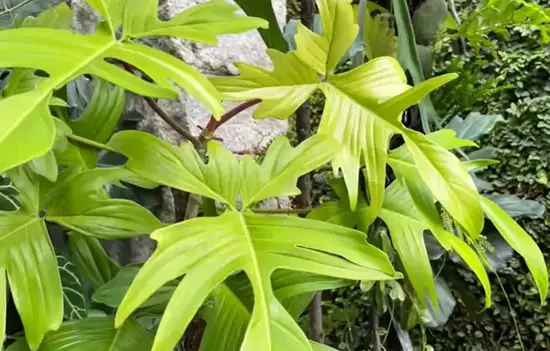The Philodendron Florida Ghost also known as Philodendron Pedatum is an affordable “rare” Philodendron that is easily attainable. Its easy care and dramatic foliage make this the perfect gateway aroid for beginners. This plant is actually a hybrid within the family Araceae and the genus Philodendron, but no one can say exactly where they come from; one of the parent plants is the Philodendron Squamiferum. However, unlike their parent plant, Philodendron Florida Ghost leaves can get absolutely huge. The unique pale white leaves draw plant lovers’ attention as the leaf shape resembles little flying ghosts- which is kind of cool!!
Philodendron is a genus of the family Araceae, native to Northern, Center, and Southern Americas. It has around 489 species making it the second-largest member of the family Araceae after the genus Anthurium. Like most Philodendrons, this tropical plant features stunning foliage and stands out as a great house plant, low-maintenance in most climates.
Closely-Related Allied Species: Philodendron White Knight, Philodendron Moonlight, Philodendron Spiritus Sancti, Philodendron Squamiferum, Philodendron White Princess, Philodendron Verrucosum, Philodendron Mamei.
Related Products:
Habitat & Ecology
| Botanical Name: | Philodendron Pedatum cv ‘Florida Ghost’ |
| Family Name: | Araceae |
| Other names: | Florida Ghost, Florida Ghost Mint |
| Plant Type: | Evergreen hybrid, Hemiepiphytic ,Vine climber |
| Origin: | North, South, and Central America |
| Color: | Leaves emerge white then turns to green |
| Height: | 2-5 feet |
| Humidity: | 60%-80%. |
| Temperature: | 64°F-77°F |
| Light Need | Bright, indirect light |
The Philodendron Florida Ghost features stunning glossy white leaves that may turn from yellow-green to darker green when reaching maturity. Interestingly when new leaves shoot, they are creamy-white and lobed instead of the conventional heart form.
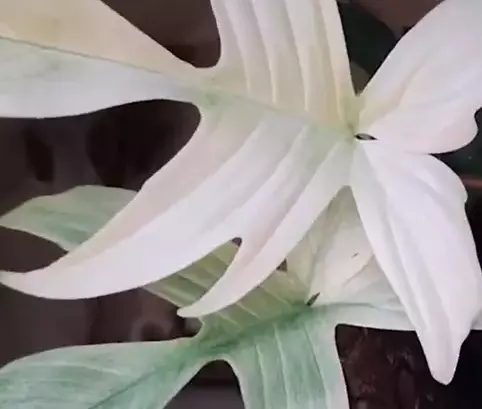
Philodendron is a Greek word for ‘hugger’ since most Philodendrons are epiphytes that live and climb up other trees. The stems of Florida Ghost are much longer than other philodendron hybrids; therefore, this plant may need strong support while reaching its full potential growth. Plus, each leaf on the plant contains several lobes.
How do You Care for a Philodendron Ghost?
The Philodendron Florida Ghost is a real treat for plant parents who enjoy tropical plants. Well, the plant’s leaves’ colour is not categorized as variegation. The leaves start as white, and as they age, they turn a pretty yellow-green and eventually, when it hits full maturity, the leaves become a darker green. It’s entertaining and easy to care for plants and purifies the oxygen air. But before buying this amazing Philodendron, you might want to learn to cultivate your own Philodendron Florida Ghost plant properly.

Where I should Place My Philodendron Florida Ghost?
The best place for Philodendron Florida Ghost is a bright South east window with indirect sunlight. The filtered light will be enough to create photosynthesis to thrive and will not burn the funky foliage.
In case of dark rooms, you can place your plant about five inches away from growing lights. Philodendron Florida ghost needs 12 hours of bright light and 12 hours of darkness to thrive. However, you might need to ensure that all leaves are exposed to the same light intensity for equal growth.

How Much Light does a Florida Ghost Need?
One factor that makes Philodendrons popular and beginner-friendly house plants are the endurance of a wide range of light conditions. Florida Ghost can thrive in both low light and highly illuminated surroundings. However, this plant does well in a little bit of direct sunlight. In fact, if you give it direct sunlight, the new leaf that comes out would be white, and some of them even have dots, and that’s why people also call them the Philodendron Florida Ghost Mint.
However, when you give it bright indirect light or a medium-light, they can handle it as well, but the new leaf will come out with a very light green, almost white color maybe but mostly light green. Later as it expands in size and matures, it will become dark green. In fact, this plant unfurls really beautifully.
From my experience, I can say that Philodendron Florida Ghost can take a medium to very bright and direct light. Note that some direct sunlight is fine but not the full sun. The beautiful foliage will absolutely scorch in full sun.
Low Light Vs Bright Light Effect:
I have noticed that if you keep them in a lower light situation (obviously, you want to water them less), they will have really long petioles as they try to reach out for the light and the internodes (which is the distance between the nodes) are going to be very long. If you give it enough light, including some direct sunlight, the internals of the plant grows very close, resulting in a beautiful, very bushy, and compact plant.
Even in case of low light, they look good when they’re climbing up and are vining up as they are looking for a light. Philodendron Florida Ghost for sure needs a moss pole because these are climbers. If you don’t give them one, their leaves will not become huge or will take a very long time and will not have a beautiful split finish.
Therefore if you fancy gorgeous extended leaves you might definitely need to give them a moss pole to grab onto it .

Humidity and Temperature
Philodendron Florida Ghost thrives at a temperature between 65-95 degrees Fahrenheit. Since it is a hybrid tropical plant, it is sensitive to cold weather and prefers a warmer climate. Therefore, keep this plant away from drafty windows, exterior doors, air conditioners, or an open window during the cold season. Florida Ghost thrives at normal house temperature.
Philodendron Florida Ghost plant thrives best in a fairly humid environment, around 65% to 80%, mimicking the natural tropical forests. However, they can adapt to lower humidity levels as well. You can provide extra humidity in the following ways.
Many homes have humidity levels below 50%, especially during the winter, because of heaters. You can use a Hygrometer to monitor the temperature and humidity.

Soil Requirements
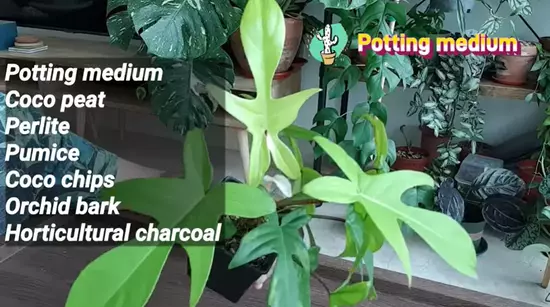
In terms of potting mix, I give it my aroid potting mix because these are epiphytes, and they want well-draining, loose, organic soil – something chunky that they can grip their roots into, and also, they don’t want to be water too much. Therefore when you give them a chunky potting mix, you fool them into thinking that they’re climbing, so they develop strong gripping roots to produce beautiful, huge leaves.
You can also use sphagnum peat moss only as a substitute for potting mix. You won’t require anything else when you use this Sphagnum as it is coarse, aerates pretty well, and allows any excess water to run right through.
You can prepare DIY Philodendron Soil Mix high in organic matter by following this recipe;
- House plant potting mix 25%
- Orchid bark 25%
- Perlite 25%
- Coco Coir or Peat Moss 15 %
- Worm castings 10% (add richness to the soil)
- Charcoal
This DIY soil mixture is high in organic matter and will also prevent water logging. If you want to buy ready-to-go soil, you can try any good Aroid mix available online or at your local plant shop. Usually, they include the Orchid Bark, Coco Coir or Peat Moss, Coco cubes, and charcoal as components of an organic mix. The key is to choose the loose, well-draining soil and slightly acidic. You can also add perlite for draining.

Potting
Since Philodendrons are prone to root rot, therefore a pot with suitable drainage holes will serve best. Florida Ghost is a climber; its roots grow downward rather than horizontally. Hence, you’ll need a deeper container than on the outside.
As already mentioned, Florida Ghost flourish in a porous medium; we recommend choosing a pot with side holes to provide aeration and drainage or preferably a transparent pot to monitor the root growth.
Florida Ghost loves to cling on to something; therefore, you can insert a moss pole to provide the extra help to climb up and vine up.
The plant can grow up to five feet tall, and the leaf can be as giant as four inches in length, depending on the surrounding environment. The top of the plant would get heavy, so choose a sturdy pot to prevent the plant from tipping over.
Avoid using a large pot as it will retain water resulting in root rot.
When To Repot A Philodendron Florida Ghost?
Philodendron Florida Ghosts are fast growers but you don’t need to repot the plant for two years. It is a misconception that they are slow growers. In fact in my experience, I noticed they grow pretty fast in favorable conditions. Once the roots start growing out of the drainage holes, it is time for a bigger pot.
The new pot must be 2 inches bigger to allow the plant’s roots to spread and breathe. The best time to repot Florida Ghost is in spring, so it has the whole growing season ahead to adjust and grow into it’s new pot.

How Often Should I Water ?
Philodendron Florida Ghost doesn’t want to be water too much. They need to be dried out between watering as they’re the standard Philodendron epiphytes, and most Philodendrons have the same watering requirements. Florida Ghost generally appreciates going close to dry before being watered fully. Most Philodendrons aren’t fussy, and it makes sense because they’re epiphytes and adapt to dryness before getting water.
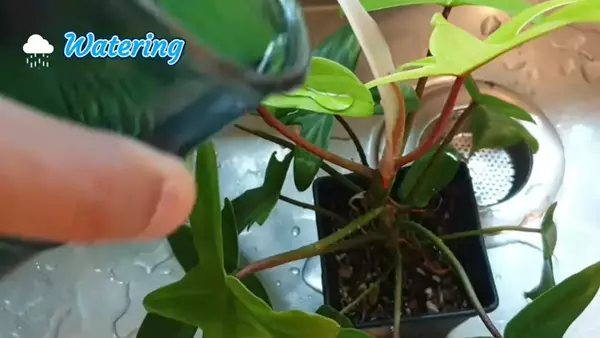
You can use a Moisture meter to determine the dryness of the soil and water your plant accordingly. Or you can use your fingers to check the moisture of the soil. You can water the plant if the topsoil is dried 2 to 3 inches, preferably 50% dry for this plant.
Usually, weekly watering works for this plant, but it may need to water more frequently during the dry or hot season. Florida Ghost plants may need water only thrice a month in the cold months.
Please ensure not to leave the plant dry for long as it will die. On the other hand, soggy soil with poor drainage can cause root rot in Philodendron Florida Ghost plants.
Note: Once you water the plant, let it drain completely through the bottom drainage holes. You can level plant on bottle caps or stones for draining and aeration (which will prevent root rot while encouraging robust root growth).

Fertilizer
Philodendron Florida Ghost plants thrive when fed by nitrogen-rich fertilizer. As this plant features gorgeous foliage, any fertilizer rich in Nitrogen will boost the leaves’ growth. Nitrogen-rich fertilizer will help the plant grow huge leaves with healthy green color. Please ensure the soil is moist or watered before fertilizing your Philodendron to avoid damaging the roots.
The best time to feed Florida Ghost is the growing season – spring and summer when the plant is shooting new leaves. You can feed any Nitrogen-rich slow release plant fertilizer to aroids. It is recommended feed the plant once a month during summer and spring. You can dilute the liquid fertilizer by half first instead feeding a total dose and carefully monitor its effect on your plant.
During winter, the plant is dormant and doesn’t have much nutritional requirements. On cooler days, no need to fertilize the plant.

How to Propagate Philodendron Florida Ghost?
The propagation of Philodendron Florida Ghost plants is relatively easy. It can be propagated by using the stem cutting or air layering method.
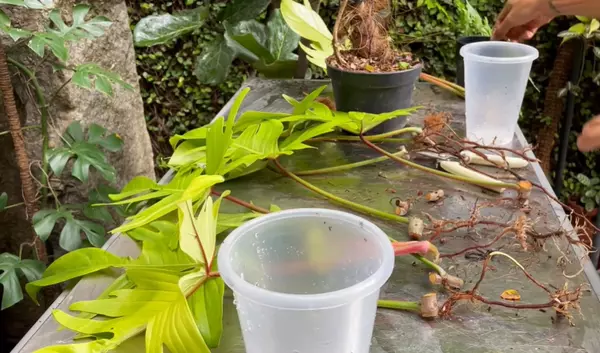
Stem Cutting Propagation
The best time to propagate the Philodendron Florida Ghost is the spring when the plant is actively growing. The new plant will root and adjust during the season. For beginners, we suggest the stem cutting method for propagation. Follow the following steps;
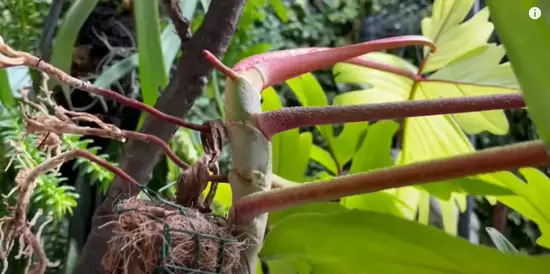
After propagation you can add a little bit of slow release fertilizer and Furadon pesticide (optional).
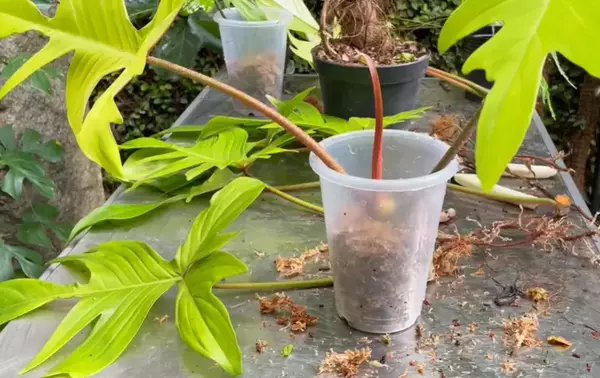
Water Propagation
The node cutting with minimal root can be put into water vessel to produce new growth points and strong roots. Once you see new growth points , take that cutting out and plant into potting mix. Don’t worry about the yellowing of the leaves while water propagation . We need new growth points and stable roots to multiply the plant.
Keep in mind after propagation, all the plant’s leaves will not grow fully green, and not all leaves will go mint. Some of them will stay relatively creamy. They’re so fast at propagating, you could stick this plant to the wall and let it climb up.
Propagating Using Air Layering

Philodendron Florida Ghost can also be propagated through air layering method. We suggest the air layering method if your Florida Ghost is young and has minimal aerial roots. Follow the following steps;
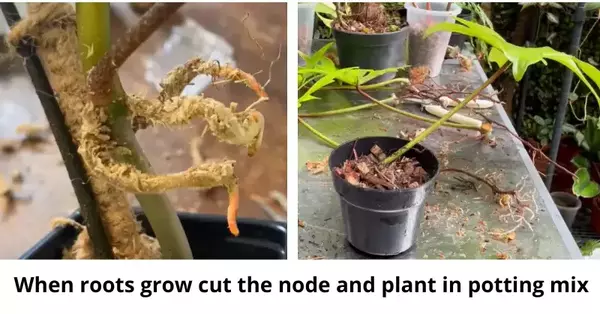

Pruning a Florida Ghost Plant
Florida Ghost grows as a vining plant and may need occasional pruning. Florida ghost leaves approach for light and may result in long astray petiole in case of insufficient light. You can prune those to encourage fuller, bushier growth. Always use a sterilized shear or pair of scissors for pruning. Additionally, prune any yellow and dead leaves to maintain the plant’s beautiful look and save its energy.

Is Philodendron Florida Ghost pet friendly?
Philodendron Florida Ghost is toxic and therefore not pet safe. Florida Ghost leaves are attractive to pets, and they may try to chew on them. Keep this plant away from your pets and children.

Common Problems
Pests
This plant is not prone to getting pests. However Aphids and mealybugs may attack this plant . You get rid of these pest by applying Neem oil to the leaves. Give your plant a blast of water with a showerhead and apply insecticidal soap.
However, Philodendron Florida Ghost produce Extra floral nectaries to deal with pests.
Extra floral nectaries;
Interestingly this plant produces Floral Nectaries (sugars) as a defense mechanism against pests. Extra Floral nectaries are little water-like droplets that happen along the petiole and sometimes the back of the leaves. That is to essentially harken the cavalry, which would be things like ants in the forest.
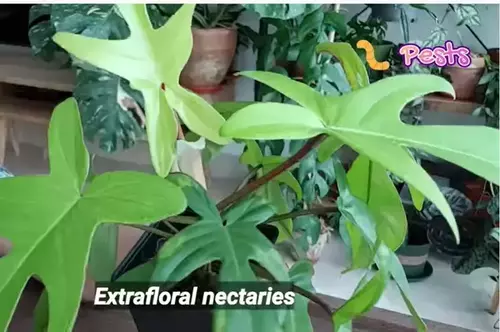
Floral nectaries are slightly sugary substances that will bring the ants, and the ants will then protect the plant from other pests that would harm the plant. The plant gets floral nectaries more in spring and summer when the plant is a bit more actively growing.
Root Rot
Philodendron Florida Ghost is prone to root rot if the potting medium is too dense or the plant is overwatered. If the roots remain damped for a longer time and don’t get aeration, it will cause the roots to rot. The symptom of root rot is the yellowing of leaves. You can repot the plant into a good drainage pot to save it from dying. Take off all the damped soil and plant it into a new porous potting mix. Moreover, prune all the damaged leaves to encourage new growth.
Yellow leaves
Yellowing of leaves is a common sign of overwatering. Be sure to let the plant dry first before watering. And after watering let the excess water drain through the drainage holes.
FAQ
Is Philodendron Florida Ghost and Florida Ghost Mint are same?
Yes, Philodendron Florida Ghost and Philodendron Florida Ghost ‘Mint’ are the same plants. Don’t get fooled by a mint Florida Ghost especially if you’re paying more to get a mint version. It’s just a Florida ghost that probably hasn’t had enough light, and as soon as you give it enough light, it will start producing the white-colored leaves. Later, the new growth that comes in obviously will start going minty and eventually turn green as the plant leaves mature.
How to Get White or Mint Leaves on a Florida Ghost?
Interestingly the colors of the leaves of Florida Ghost depend on the amount of light the plant is getting. The plant will produce creamy white leaves when the plant is very close to a grow light (or getting strong indirect sunlight from a southeast window ). Be careful if you grow light to produce heat; you might not want your plant touching those lights. It may burn the leaves. If the leaves are a bit away from light, they will grow green or nice mint color depending on their light exposure. Eventually, the older leaves will turn green.
Is Philodendron Florida Ghost rare?
Yes, you can say that Florida Ghost is a rare specie that got its name from the shape and color of its leaves. It is not very common to find this plant at every plant nursery.
Can a Philodendron Florida Ghost revert?
Well, the answer is no. Actually, when you get the Florida Ghost from the market, its leaves are creamy-white and minty. After some time, you notice that all the leaves turn green. Well, what happened is that the new leaves grow white as long as it gets very bright indirect light. The fresh leaves will grow minty and dark green if not given enough light. Also, as the leaves mature, their color changes from creamy white to minty and eventually green.
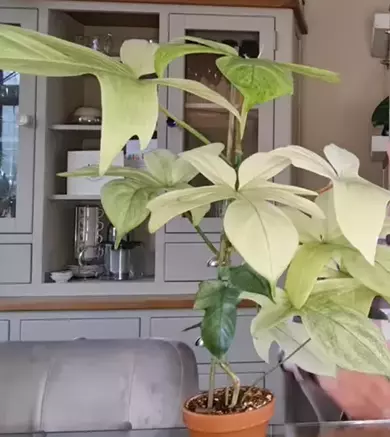
Is Florida Ghost same as Florida beauty?
Florida beauty and Florida ghost are Pedatums and have the same leaf shape. The Florida beauty is a variegated version of the Pedatum, featuring dark green leaf and white green splotches on each leaf. On the other hand, the Florida Ghost produce minty or creamy white ‘Ghost’ leaves that darken green as they mature.
Why does Philodendron Florida Ghost leave edges to turn brown?
Brown leaves on a Florida Ghost Philodendron are a warning of low humidity. As these plants are tropical, so they need high humidity, around 50% to 70%. You can increase humidity by using a plant humidifier. Also, the white leaves of Florida Ghost may have brown edges because they lack Chlorophyll that produces plant food.

